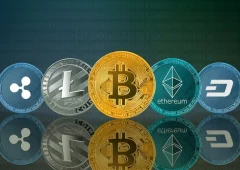Why Gold Could Be the Smart Play Amidst US Debt Surge
11.06.2025 11:00 1 min. read Alexander Stefanov
With the US government preparing to unleash over $1 trillion in new debt, bonds might take a back seat to commodities as a safer bet, according to Larry McDonald, founder of "The Bear Traps Report."
He projects roughly $1.5 trillion in fresh government debt issuance between this September and next February, a significant jump from last year.
This massive influx of bonds, coupled with persistent federal deficits, could heavily pressure an already volatile bond market. McDonald anticipates a huge shift: $4 to $6 trillion moving from “paper” financial assets (stocks, bonds) into “hard assets.”
What are these hard assets? Think precious metals like gold, silver, and platinum, which have already performed well this year. Agricultural commodities are also on his radar. McDonald suggests a radical shift from the traditional 60/40 portfolio (stocks/bonds) to a “30/30/30/10” split, with a much larger chunk (30%) in commodities and 10% in cash.
For everyday investors, gaining direct exposure to commodities can be tricky. However, ETFs like the Invesco DB Agriculture Fund (DBA) and SPDR Gold Shares (GLD) offer accessible ways to invest. While McDonald isn’t predicting an immediate bond market crash, the sheer volume of anticipated debt makes a strong case for fortifying portfolios with tangible assets.
-
1
Trump Imposes 50% Tariff on Brazil: Political Tensions and Censorship at the Center
10.07.2025 7:00 2 min. read -
2
Key Crypto Events to Watch in the Next Months
20.07.2025 22:00 2 min. read -
3
USA Imposes Tariffs on Multiple Countries: How the Crypto Market Could React
08.07.2025 8:30 2 min. read -
4
UAE Regulators Dismiss Toncoin Residency Rumors
07.07.2025 11:12 2 min. read -
5
Ripple Selects BNY Mellon as Custodian for RLUSD Stablecoin Reserves
09.07.2025 15:28 2 min. read
Two Upcoming Decisions Could Shake Crypto Markets This Week
The final days of July could bring critical developments that reshape investor sentiment and influence the next leg of the crypto market’s trend.
Winklevoss Slams JPMorgan for Blocking Gemini’s Banking Access
Tyler Winklevoss, co-founder of crypto exchange Gemini, has accused JPMorgan of retaliating against the platform by freezing its effort to restore banking services.
Robert Kiyosaki Warns: ETFs Aren’t The Real Thing
Renowned author and financial educator Robert Kiyosaki has issued a word of caution to everyday investors relying too heavily on exchange-traded funds (ETFs).
Bitwise CIO: The Four-Year Crypto Cycle is Breaking Down
The classic four-year crypto market cycle—long driven by Bitcoin halvings and boom-bust investor behavior—is losing relevance, according to Bitwise CIO Matt Hougan.
-
1
Trump Imposes 50% Tariff on Brazil: Political Tensions and Censorship at the Center
10.07.2025 7:00 2 min. read -
2
Key Crypto Events to Watch in the Next Months
20.07.2025 22:00 2 min. read -
3
USA Imposes Tariffs on Multiple Countries: How the Crypto Market Could React
08.07.2025 8:30 2 min. read -
4
UAE Regulators Dismiss Toncoin Residency Rumors
07.07.2025 11:12 2 min. read -
5
Ripple Selects BNY Mellon as Custodian for RLUSD Stablecoin Reserves
09.07.2025 15:28 2 min. read


